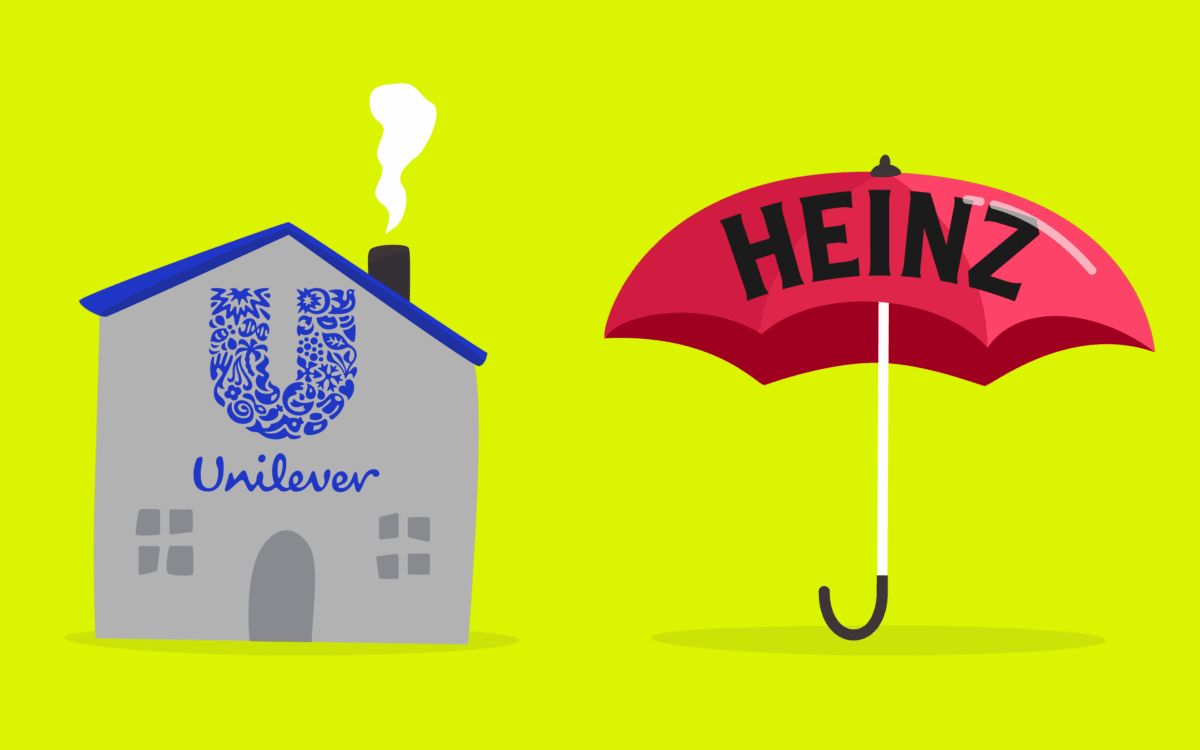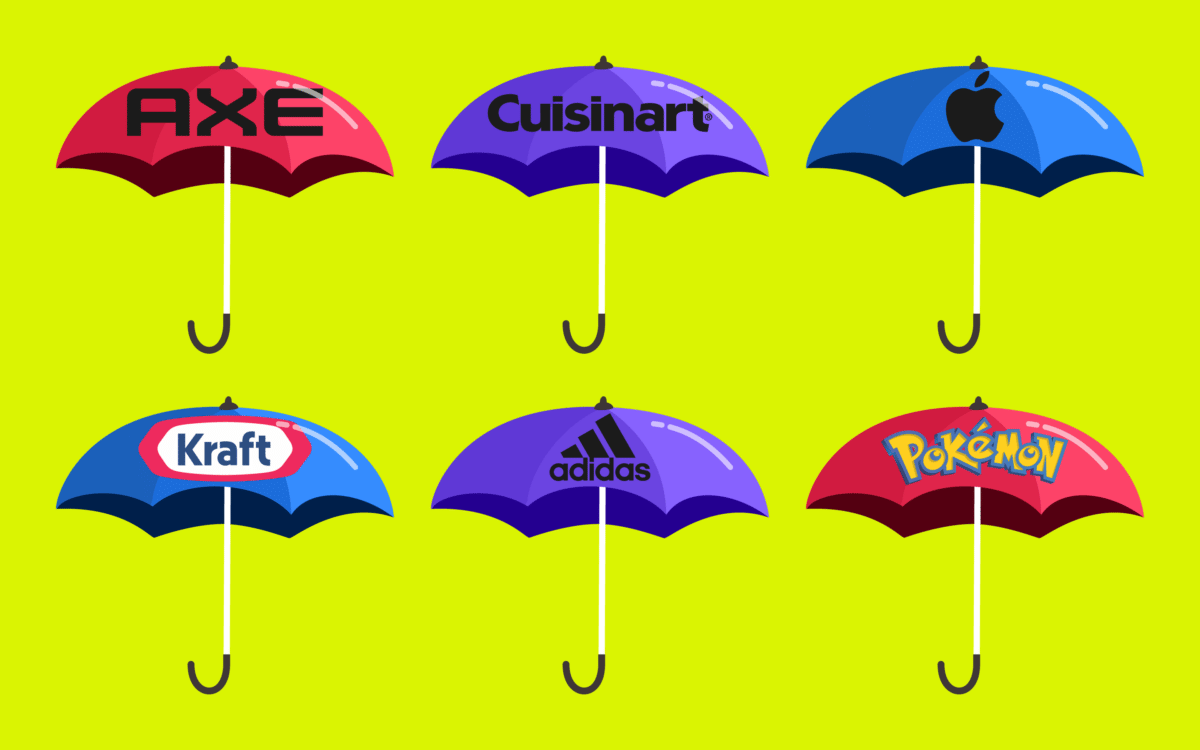What is an umbrella brand? Everything you need to know about umbrella branding

How much do you know about umbrella branding? While you might have a basic idea of what this term means, the concept of an “umbrella brand” is frequently misunderstood, and even confused with other concepts, like the “house of brands”. So, what is an umbrella brand?
An umbrella brand is a kind of brand architecture strategy, which involves using a single name or logo for a variety of related products. Consider how FedEx has a huge range of products dealing with different kinds of logistics and shipping.
Umbrella branding can be a valuable tool for companies who want to serve their customers in a variety of different ways, while still maintaining a strong identity in relation to a specific industry.
Today, we’re going to take a closer look at the question “What is umbrella branding?” to help you understand whether it might be the right strategy for your company.
What is umbrella branding?
An umbrella brand is the process of using a single name, logo, and overall brand identity to connect a range of related products, for different needs.
One great example of this would be the “Heinz” company. The Heinz brand places its unique logo on everything from baked beans tins to tomato ketchup bottles and salad creams.
Sometimes referred to as “brand families”, umbrella brands involve placing the same imagery on a range of different products, to align them within the same brand ecosystem.
This is a direct alternative to individual branding, where every item has its own distinct image, despite belonging to the same company. For instance, P&G has separate sub-brands for Tide, Pampers, Always, and so on.
Umbrella brands generally start as individual brands. Heinz started off making nothing more than pickles. However, as the company evolved and began exploring new categories, new products started to emerge for different purposes.

House of brands vs umbrella branding
One of the most common ways people make mistakes when defining umbrella branding, is by treating it as the same as a “house of brands”. A house of brands is a parent company which creates a range of products sold through different smaller brands, like P&G.
With a “house of brands” we see a multitude of different organizations held under the same larger business. For example, Unilever is “home” to a wide range of different smaller organizations, like Dove, Hellman’s, and Cif. None of these products use “Unilever” branding, however.
While umbrella brands want to maintain a consistent image, a house of brands is fine with the underlying companies having no obvious connection to the bigger corporation.
Why companies use umbrella marketing
Umbrella marketing and umbrella branding are commonly used by companies who want to reduce their investment in launching new products within the same wider niche or category. It takes time to develop brand equity for a new product or company entirely disconnected from the primary brand.
With an umbrella brand, the work is minimized, because you’ve already built a name for your company which the products can build on.
Notably, Umbrella branding generally only works well when companies apply their brand to new products which make sense, and feel relevant to the existing offering from the company.
When Cosmopolitan tried to launch a line of yogurts, the new offering didn’t appeal to customers as significantly as the company thought, because people couldn’t see the connection. Forcing a new product under your umbrella when it doesn’t fit just causes confusion.
Adding too many complex and differing products to a line can also cause additional problems. Even if your customers accept the introduction of a new, slightly less relevant item, it can gradually dilute the impact of your company.
People will start to feel uncertain about what your vision is, or what your company stands for.

The pros and cons of umbrella brands
As mentioned above, umbrella branding can have a number of significant benefits when used correctly. It reduces the investment you may need to make into your new product to ensure it has the right impact on your audience.
Plus, an umbrella branding strategy doesn’t require companies to spend a fortune on new logos, color palettes, website designs and so on.
However, umbrella branding doesn’t work for everyone. If the product you want to sell is a world apart from your existing portfolio, it won’t make the right impact. At the same time, there’s always a risk producing one bad product could damage your entire company’s reputation.
The pros of umbrella branding
Instant brand equity
If your brand already has a strong reputation in your chosen industry, you can instantly leverage this impact with an umbrella brand.
Your existing presence in the marketplace will give your company more credibility, and make it more likely customers will want to try your product straight away.
Decreased advertising costs
As mentioned above, you won’t need to place nearly as much effort into designing new logos and promotional elements for an umbrella brand product. You’ll already have a strong brand image to work with.
Plus, you shouldn’t have to work as hard to find customers, because you already have a presence.
Quicker sales
Since you’ll already have a selection of loyal customers purchasing your existing products, you’ll be able to get your new item in front of paying consumers as quickly as possible. This helps you to make money more rapidly.
In addition, your existing customers can help advertise your brand to new prospects through word of mouth.
Variety
With umbrella branding, you don’t have to launch products in the exact same line, as long as they’re related. This allows you to branch out into other areas.
For instance, if you’re known for selling body wash, you could sell shampoo and conditioner products too. This ensures you can reach a wider audience.
Increase sales
The more products you launch with a direct focus on reaching the right target customer, the more you’ll be able to unlock new sales opportunities. A better market share and bigger sales helps your business to grow.
The cons of umbrella branding
Brand dilution
Choosing products to launch under your umbrella brand is something you’ll need to consider very carefully. Launching unrelated goods will confuse your audience and damage your brand reputation.
While products don’t have to be exactly the same, they should have a significant connection your audience can understand.
Expectations
It’s difficult to experiment with new products you’re not sure will have the right impact with an umbrella brand. Your customers will already have certain expectations of your company you need to live up to.
Reputation damage
Failure to live up to your customer’s expectations with a single product under your umbrella brand can ruin your entire reputation. All it takes is one bad interaction with a company for a customer to completely change their perspective of the brand.

How do you start an umbrella branding strategy?
Now you know the answer to “what is an umbrella brand?” you can determine whether umbrella branding and marketing techniques might be relevant for your company. Notably, you will need a strong strategy to ensure this process works.
As mentioned above, it’s easy for a small mistake in your umbrella branding efforts to disrupt your entire brand.
So, how can you begin your strategy?
Create a plan
The first thing you’ll need, is a long-term plan for your company. Sit down with your business plan, your brand vision, and ask yourself where you want to expand your brand in the years to come.
Think about the underlying mission of your business, and why you started the organization in the first place. What do you want to do for your customers?
Every branded product you add to your portfolio should serve this mission. Whenever you’re introducing a new item, ask yourself, “does this help me to fulfil my brand promise?”
Know your customers
Make sure you’re aware of your target audience, and the audiences you might be able to branch out and connect with.
Don’t try to reach too many distributed groups at once with your umbrella brand. Trying to go in too many different directions can end up meaning you don’t appeal to any specific audience. However, remember you can be a little versatile.
You might end up creating different audience personas for specific products. For instance, you might have a moisturizer concentrating on younger customers, and one for older consumers.
Know your core product
Decide what your core product is going to be. Apple, for instance, sells computers as its primary product. However, it can also offer a range of other tech items under the same umbrella, like phones and music systems.
The core product you choose will help you to define which areas you can branch out into, while remaining relevant. Remember, even if the new products you introduce aren’t directly linked to your core product, there needs to be a clear connection.
Build a strong brand image
At the heart of an umbrella branding strategy is a consistent image you can take with you when introducing every product. You’ll need a high-quality logo you can include on every product.
This means ensuring the design you choose is versatile enough to suit a range of products in related sectors.
It is possible to experiment a little with your brand image, such as using different colors for different products, like Coca-Cola does with the Coke line.
Nail down your personality
Just as it’s important to maintain a consistent brand image with your umbrella brand, you’ll also need a strong personality. This personality should show through in your umbrella marketing campaigns, and remind your customers of who they’re dealing with.
Ask yourself how you’re going to speak to your audience, what sort of language you’ll use, and what kind of emotions you want to evoke.
Notably, it’s also worth taking the time to go through each potential addition to your product portfolio carefully when expanding your brand. Get insights from the shareholders in your team, and make sure every new creation makes sense.

Umbrella branding examples: Inspiration to learn from
If you’re still a little confused about the question “what is an umbrella brand?” it might be helpful to look at some companies already investing in umbrella branding. There are plenty of great options out there to consider.
Here are some great umbrella branding examples:
Axe / Lynx / Ego
Owned by Unilever, Axe is a fantastic example of an umbrella brand. The company offers a range of products to customers in different environments, but they maintain the same image, identity, and focus throughout their entire portfolio.
For instance, the core product sold by Axe is deodorant, but the company also offers conditioners, shampoos, scrubbers, body washes, fragrances, and hair styling products. All of these items are focused on the same vision of making men feel more confident.
The Axe umbrella brand makes sense because it doesn’t try to reach a completely new audience, but instead produces various different products which can be used to the same end – building self-esteem.
Cuisinart
Another excellent example of an umbrella brand with its own parent company, Cuisinart sells a host of different items, all connected to the kitchen and cooking environment. You can find various food processors, blenders, mixers, juicers, toasters, grills, and kettles all produced by this company.
Though Cuisinart has a huge portfolio of different products, the company avoids brand dilution by focusing on the same wider theme – the kitchen.
The brand started life as a food processing company, before gradually introducing adjacent products which could also make life more convenient in the kitchen.
Apple
We mentioned the Apple brand above, but it’s definitely one worth looking a little more closely at if you’re interested in umbrella branding. At its heart, Apple is a technology company which started off producing computers intended to be more accessible to the masses.
Over the years, Apple has expanded its focus on other forms of innovative technology, concentrating specifically on the tech environment. The company now has a range of phones, smart watches, headphones, smart speakers, music streaming services, and even payment solutions.
Apple continues to maintain a strong brand identity no matter how many new products it introduces, because it has a clear vision of its target audience, and its identity, which revolves around innovation.
Kraft
One of the most commonly mentioned examples of umbrella branding, Kraft has created a whole ecosystem of varied food products for its audience. The company is best-known for creating convenient foods, such as microwavable meals and pre-wrapped cheese singles.
While Kraft does belong to a house of brands (Kraft-Heinz), it also produces a range of different items with the same consistent logo and brand identity. Products range all the way from Kraft Dinner to Miracle Whip, and marshmallows.
The company’s main focus is on producing products intended for simple food preparation and accessibility. Anyone can enjoy Kraft products without needing any distinct cooking skills.
Adidas
One of the biggest sporting companies in the world, and one of the best-known athletic logos, Adidas didn’t always offer the huge selection of products we’re familiar with today. The company started with a strong focus on sneakers and training shoes.
However, it eventually evolved to explore more of the athletic landscape.
Today, Adidas produces shoes, sandals, t-shirts, sports bras, shorts, skirts, hats, socks, and even various sporting accessories, like footballs. Like many of the most popular umbrella brands on the market right now, Adidas remains strong because of a consistent theme.
The company can reach a huge selection of different customers, but it still centers all of its new products around the athletic world.
Pokémon
An Umbrella brand with a slightly younger target audience than many of the options mentioned here, Pokémon has turned into a significant household name over the years. The company started as an anime, and eventually started applying its logo to a range of different child-focused products.
Today, the company sells toys, apparel, stuffed animals, comic books (manga), television programs, films, trading cards, console games, and more. The reason this umbrella brand is so successful is it produces products with a consistent personality, and a focus on a specific audience.
All of the products in the Pokémon portfolio center around the world built by the company, and their customer’s desire to connect with the environment.
Tips for success as an umbrella brand
Forming an umbrella brand can be a useful strategy for some business leaders. It’s an opportunity to make a consistent name for yourself in your chosen industry, and make your products more recognizable to your customers.
At the same time, umbrella branding can help you to save some cash on your marketing and advertising campaigns. You won’t need to invest in building a new image from scratch every time you create a new line of products.
Of course, there are some down sides too.
One bad product can lead to negative associations with your entire brand. Plus, there’s a risk you may end up diluting your company’s image if you produce too many products far removed from your existing “core product”.
When building your own umbrella brand:
Know your core brand identity
An umbrella brand needs a strong identity capable of extending across multiple products in a shared niche or space. Understanding your identity, from your visual appearance to the messaging you use to connect with customers will be crucial for making your brand as strong as possible.
Understand your audience
Make sure you have a clear vision of your audience, what they expect from you, and what kind of pain points you want to address. The more you get to know your target customer, the easier it will be to stay focused with your new offers.
Stay relevant
Remember an umbrella brand allows you to extend into related areas of your product landscape, rather than focusing too closely on one thing. However, you’ll still need to make sure the products you produce make sense for your customers.
Don’t make the mistake of diluting your brand too far.
Have a clear mission
A good mission or vision for your brand will act as a compass when you’re not sure whether to add another product to your umbrella brand, or stay as you are. Make sure you add your mission to your brand guidelines and refer to it frequently.
Get the right support
From shareholder support to make decisions about growing your business, to assistance from graphic designers to make your brand as eye-catching as possible, don’t try to go it alone.
Exploring the benefits of umbrella branding
Umbrella branding can have a lot of advantages for growing companies in the right circumstances. However, it’s important to ensure you’re using your umbrella brand correctly.
Above, we answered the question “what is an umbrella brand?” but we also offered an insight into how you can make an umbrella brand as successful as possible.
Make sure you think carefully about whether an umbrella brand is really suitable for your needs before you dive into your new venture.
Fabrik: A branding agency for our times.

We’ve built our reputation, building brands for other people.
Do you need to bring a new brand to life or breathe new life into an existing one? If so, let’s start a conversation
















